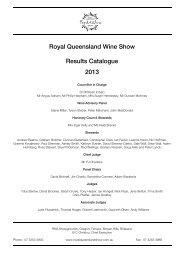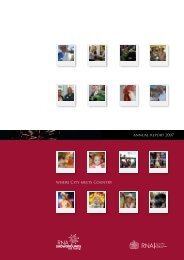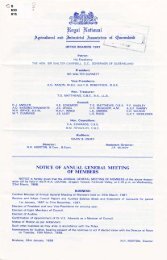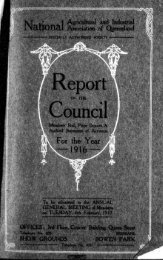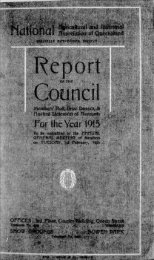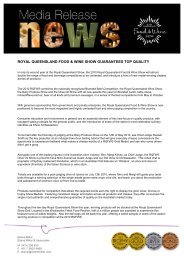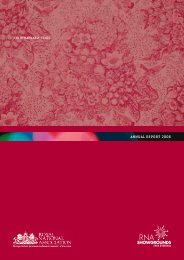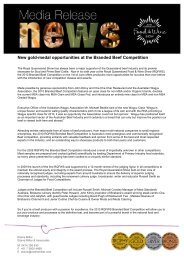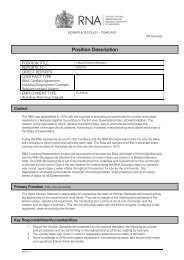Il--laaLI , a~k~3~e~suP~lb~bsrssl~aaasAr~Ali~s~~ /_~ _"They all believed that in <strong>the</strong> fulness of time, Queenslandwould become <strong>the</strong> centre of Australia's prosperity and greatness,and <strong>the</strong>y wanted <strong>the</strong> Governor-General and Lady Forster to believethat, too. (Applause). The Royal National Association was doingwhat it could to hasten that time, and it deserved every supportin its work. He had no doubt that <strong>the</strong> Association still wouldhave a continuance of <strong>the</strong> assistance of <strong>the</strong> City Council in <strong>the</strong>maintenance and development of what, after all, was <strong>the</strong> city'schief annual attraction to visitors from <strong>the</strong> country and from o<strong>the</strong>rStates.Queensland being <strong>the</strong> premier (attle State, it was natural thatit should have <strong>the</strong> finest Australian specimens of Shorthorns andHerefords. But <strong>the</strong> State's growing industry, from which mustcome that closer settlement so necessary for her, was dairying,and it was well to see so goodly an array of Milking Shorthorns,Jerseys, Frisians, and Ayrshires.Wool growing was represented more by samples of fleeces thanby <strong>the</strong> sheep <strong>the</strong>mselves, although <strong>the</strong>re were sonie fine fat we<strong>the</strong>rs.The dairy herds lid <strong>the</strong>ir complement in Pigs fedil on dairy byproducts.There well might be more Pigs. Good as were <strong>the</strong>exhibits of Stock and Poultry, what would strike <strong>the</strong> visitor most,probably was <strong>the</strong> Produce Sections. The mere enumeration of <strong>the</strong>principal items <strong>the</strong>re, cheese, butter, condensed milk, honey, maize,wheat, sugar cane, cotton, citrus and more tropical fruits, allillustrated <strong>the</strong> Stat,'s vast productiveness, while <strong>the</strong> exhibit of <strong>the</strong>State ('annery, of <strong>the</strong> Soul llher Queensland Fruit-Growers' Society,and, ra<strong>the</strong>r surprisingly, of <strong>the</strong> Charleville District, gave specialprominence to <strong>the</strong> fruit industry.West Muretoii, Wide Bay, and Burlnett, Darling Downs,Kingaroy, and Wallumbilla each had exhibits which surpassed by<strong>the</strong>ir variety and1 pleased by <strong>the</strong>ir excellence. They showed that<strong>the</strong>re was sonme gool fannring in <strong>the</strong> State, but he felt bound toadd, after going ra<strong>the</strong>r cursorily through <strong>the</strong> Exhibition, and alsothrough <strong>the</strong> State, that he wished <strong>the</strong> general average of stockand agriculture more nearly approached <strong>the</strong> high standards which<strong>the</strong> Royal National Association achieved at its Show. Queenslanders,although <strong>the</strong>y rightly spoke with pride of <strong>the</strong>ir country,wrongly neirlected to make <strong>the</strong> most of it. There was waste ofland and water, of grass andl fruit, of wood and labour. He wasconstantly told by men who knew that <strong>the</strong>re was too much goodland available for any stimulus to close settlement-that was for<strong>the</strong> farming of small areas by good methods of agriculture, takingcare always to put back into <strong>the</strong> land what was taken out of it.There was too much growing of <strong>the</strong> same crop, year after year,in <strong>the</strong> belief that <strong>the</strong> soil's nutritive powers were inexhaustible,or in <strong>the</strong> knowledge that virgin soil was available to take <strong>the</strong>place of <strong>the</strong> worked out land. In a country where <strong>the</strong>re waspractically no irrigation, <strong>the</strong> waste of water was too patent toneed remark. The waste of grass was twofold, for it entailed lossof stock in times of drought, and also it was wasted on poorquality stock, which consumed as much as those returning a muchbetter yield. He was assured by cattlemen that cross-breedingtendered to inferiority of stock after <strong>the</strong> first progeny, and heknew that 193 gallons of milk per cow per annum was a pooraverage for <strong>the</strong> milking herds of <strong>the</strong> State. (Hear, hear). "Gradeap <strong>the</strong> herd and conserve forage," should be <strong>the</strong> aim of everycattleman, and particularly of <strong>the</strong> dairyman. Those were <strong>the</strong>Ssy,i*
v :principles which were being preached by <strong>the</strong> Agricultural Departmentand <strong>the</strong> Royal National Association, both of which wereproduction of Queensland. It was pitiable to see <strong>the</strong> waste offruit which had occurred at Stanthorpe, and in o<strong>the</strong>r parts of <strong>the</strong>State, and <strong>the</strong> glutting of <strong>the</strong> markets because of insufficientmeans of preservation. He, <strong>the</strong>refore, hoped that <strong>the</strong> Dehydratingprocess which could be seen in operation at that Show, would besuccessfully established on co-operative lines in each fruit growingdistrict, and thus enable fruitgrowers to take advantage of worldmarkets.C. There was ano<strong>the</strong>r industry in which <strong>the</strong> waste was greatereven that <strong>the</strong> waste of grass, and that was <strong>the</strong> timber industry.5. In some parts of Queensland, timber-getting was tantamount toh timber-destruction. They were daily realising, however, <strong>the</strong> valueof timbers, which yesterday one thought useless and to-morrowmight be non-existent. There were few things in <strong>the</strong> Exhibitionof greater interest or more importance than <strong>the</strong> Forestry Department'sdisplay.''In his concluding remarks, his Excellency referred to <strong>the</strong> greatneed in Queensland of Agricultural Science. "We want purescience at <strong>the</strong> top," he declared, "and its complete applicationbelow. At <strong>the</strong> top, I believe we should have an Agricultural Chairat <strong>the</strong> University, with special facilities for <strong>the</strong> gaining of knowledgeby research, and <strong>the</strong> imparting of it by lectures and demonstrations,to farmers' unions, and to colleges and schools, and Ishould like to see some generous persons, who in <strong>the</strong> past have mademoney out of <strong>the</strong> land of Queensland, provide, by <strong>the</strong> establishmentof such a Chair, for making that land more productive in <strong>the</strong>future. Below, we want in every man on <strong>the</strong> land a desire forthat knowledge which will get from every acre <strong>the</strong> best it willyield now and in <strong>the</strong> future." (Loud applause).The proceedings terminated with cheers for <strong>the</strong> Vice-regalvisitors.OFFICIAL LUNCHEON.The Official Luncheon which, as usual, took place in <strong>the</strong>Exhibition Hall, was one of <strong>the</strong> most successful of its kind heldunder <strong>the</strong> auspices of <strong>the</strong> Association.The President of <strong>the</strong> Association (Mr. C. E. M'Dougall) occupied<strong>the</strong> Chair, his Excellency <strong>the</strong> Governor-GeneralI (Lord Forster) beingseated on his right hand, and his Excellency <strong>the</strong> State Governor (SirMat<strong>the</strong>w Nathan) on his left. O<strong>the</strong>rs on <strong>the</strong> platform were, her Excellency,Lady Forster, <strong>the</strong> Premier (Mr. E. G. Theodore), Mr. and Mrs.Ernest Baynes, Mrs. M. Gordon, Mrs. l)everell, Colonel and Mrs. Parsons,Miss Sylvester Samuel, Major-General and Mrs. J. H. Bruche, <strong>the</strong> Archbishopof Brisbane (Dr. Donaldson), <strong>the</strong> Mayor of Brisbane( AldermanH. J. Diddams), and Lord Digby, A.D.C. to <strong>the</strong> Governor-General."The King," was proposed by Mr. McDougall, who also submitted"The Governor-General." In doing so, he voiced <strong>the</strong> pleasure thatQueenslanders felt at His Excellency 's presence, and at <strong>the</strong> keen interes<strong>the</strong> had evinced in all he had seen at <strong>the</strong> Show. He hoped that Lord and' Lady Forater would be with <strong>the</strong>m for a long term-a term in which he
- Page 1 and 2: 9';1 -,'~,&4'*.ALCiasSiSSpciay Alth
- Page 3 and 4: Royal NationAgricultural and Indust
- Page 5 and 6: EiLij., .:., .. *. . *: .Although t
- Page 7 and 8: Exhibits warrants an even greater o
- Page 9 and 10: CLOAK ROOM. Recognising the necessi
- Page 11 and 12: ,were constantly surrounded. Space
- Page 13 and 14: P r-~ -~,f.~ ~~'" s,.- "'11-~ 1.~~V
- Page 15: The President, Mr. C. E. McDougall,
- Page 19 and 20: STABILISING PRICES.The toast of "Th
- Page 21 and 22: W. J. Affleek and Miss Affleck, the
- Page 23 and 24: - Maynar4, Mr. and Mrs. A. Murphy,
- Page 25 and 26: RETIRING MEMBERS OF COUNCIL AND AUD
- Page 27 and 28: While admitting the excellency of t
- Page 29 and 30: w -'X. The installation of a Septic
- Page 31 and 32: and our Association will have to co
- Page 33 and 34: ~~u!~~~b' ~ ~ flnl~~~ik~-t~i rt pri
- Page 35 and 36: 84STATEMENT of RECEIPTS adRECEIPTS.
- Page 37 and 38: __ROYAL NATIONAL Agricultural and I
- Page 39: District Exhibits.PRIMARY PRODUCTS
- Page 42 and 43: *.ElSPMAZYPRODUCTS ONLY.B GRADEIn t
- Page 44 and 45: _ __ ~-. . ^_~ 1. _n.i~.ri~i P~ "'i
- Page 46 and 47: V' . • ,- . .... ~.r!^. .. u~l ._
- Page 48 and 49: 7 --'tUtAn8glin 2nd of Berry.M. 21.
- Page 50 and 51: ' **f'ir* PHet of 1t7 Vilw.M. 19.4
- Page 52 and 53: (4). 8. H. Hosking's Duchess of Han
- Page 54 and 55: - C-.~u~- r~i~Bnsllramr~pkr~iurwr~z
- Page 56 and 57: td1-iPiLISO'P PRIZE DONORS-continue
- Page 58 and 59: gr~~~~~~ -. *naPus-.~~l.; ^''**' "
- Page 60 and 61: ~ggC -~-- ---- """"--""1F ^ .~~s~"-
- Page 62 and 63: ANNUAL MEMBERS-Continued.p k. Mrs.
- Page 64 and 65: ~4"-P~~P""~'"Y~e~~i~L~'~d~C~~rrown.
- Page 66 and 67:
Oblde,L. A., "Birralee," First Aven
- Page 68 and 69:
I I'I~- ~--I ~ la~llllRnAI~YBu~-~;6
- Page 70 and 71:
ANNUAL MEMBERS-Continued.FPaella, A
- Page 72 and 73:
-C LL~ ^~-~~I~-~ __~_C_ __ ~r__~EEi
- Page 74 and 75:
ANNUAL MEMBERS--Continued.rIelderso
- Page 76 and 77:
75A\NNUA I M~EMBUE RS-Continued.tlJ
- Page 78 and 79:
77ANNUAL MEMBERS-Continued.Lee, W.
- Page 80 and 81:
I 9 tar IP~s3~P ~a~%s~~~t~e~Z~n~71)
- Page 82 and 83:
RIL II II r,-81ANNUAL MEMBE:McGrego
- Page 84 and 85:
_(I_ __ CC_ _sdsC~_rX__~_iC___ ~~i.
- Page 86 and 87:
' Tf V" **-85ANNUAL MEMBERS--Contin
- Page 88 and 89:
Z:IF----s~ -- rasasa~a~~r~T~LL~l'i~
- Page 90 and 91:
_ ~ ~~ ~ ~ ~ ~~~~~~~~ ~ _ ~ ~ __ _
- Page 92 and 93:
a~c~i L --- ~ 9 -I - Ds~C-rmPWB~-~I
- Page 94 and 95:
1 :'~-"r."~$' ~ .~~,P L~I - ~; n~.;




